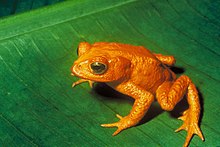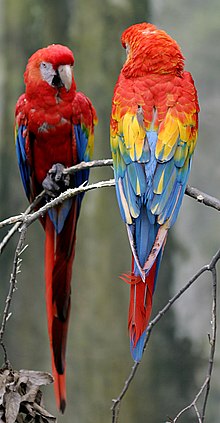User:Jkohles422/sandbox
The Wildlife of Costa Rica comprises all naturally occurring animals, fungi and plants that reside in this Central American country.
Biodiversity
[edit]Costa Rica is considered to possess the highest density of biodiversity of any country worldwide.[1] While encompassing just one third of a percent of Earth’s landmass, approximately the size of West Virginia, Costa Rica contains four percent of species estimated to exist on the planet.[2] Of all 90,000 identified species throughout the earth, Costa Rica boasts five percent of their presence within their borders.[1] Hundreds of these species are endemic to Costa Rica, meaning they exist nowhere else on earth. These endemic species include frogs, snakes, lizards, finches, hummingbirds, gophers, mice, cichlids, and gobies among many more.[3]
Costa Rica’s biodiversity can be attributed to the variety of ecosystems within the country. Tropical rainforests, deciduous forests, Atlantic and Pacific coastline, cloud forests, and Mangrove forests are all represented throughout the 19,730 square miles of Costa Rica’s landmass.[4] The different ecological regions are comprised of twelve climactic zones. This variation provides numerous niches which are filled by a diversity of species.
Benefits to Humanity
[edit]Costa Rica demonstrates the benefits of biodiversity conservation for developing countries. Over twenty-seven perfect of the country’s land has a protected status as national parks, wildlife refuges, forest preserves, and more.[5] The Costa Rican government is active in protecting its biodiversity for the ecological services they provide. The government imposes a five percent tax on gasoline to generate revenue to pay landowners to refrain from clear-cutting on their land and instead to create tree plantations. This provides Costa Ricans, or “Ticos” as they call themselves, incentive to become active tree farmers instead of cattle ranchers.[6] Tree farms provide some habitat for wildlife, enabling some measure of biodiversity to remain in these areas despite humans’ use of these natural resources. Costa Rican government demonstrates a desire for biodiversity conservation as they were the first country of Central America to sign the Convention on International Trade in Endangered Species (CITES).[7]
Costa Rica’s biodiversity contributes to the numerous ecological services the environment provides. Every aspect of the ecosystem from the different species of plants to the diversity of animal species contributes to natural services like water purification, provision of food, fuel, fiber, and biochemicals, nutrient cycling, pollination and seed dispersal, and climate regulation, just to name a few.[8] As the diversity of species increases, more of these services can be provided and to a greater extent.
Biodiversity has contributed to the economy of Costa Rica. Ecotourism brings in 1.92 billion dollars in revenue for the country.[9] Ecotourism is defined as "tourism directed toward exotic, often threatened, natural environments, especially to support conservation efforts and observe wildlife." Costa Rica's abundant biodiversity makes the country an attractive destination for ecotourism. Thirty-nine percent of tourists cite nature as their primary reason for visiting the country.[10] The profitable industry of ecotourism entices businesses to capitalize on natural resources by protecting and preserving them rather than consuming them.
Threats to Biodiversity
[edit]Threats to Costa Rica’s biodiversity include a rapidly growing population, developing coastlines for the industry of tourism and harmful agricultural practices all contributing to pollution and environmental degradation. The practice causing the largest concern for Costa Rica’s environment is deforestation. Costa Rica has the fourth highest rate of deforestation in the world. Almost four percent of its current forested lands are cut each year. Clearing land for cattle ranching is the most common cause of deforestation. This form of environmental damage along with the farming of monocultures leads to areas where only a few species of plants are present. Ultimately, decreases in plant diversity leads to decreased animal diversity.[7]
Butterflies and moths
[edit]Ten percent of known butterfly species worldwide reside in Costa Rica.[11]
Amphibians
[edit]Representatives of all three orders of amphibians - caecilians, salamanders, and frogs and toads - reside in Costa Rica. Due to environmental degradation and the sensitive nature of amphibians to pollution, Costa Rica has seen declines and even extinctions in amphibian populations. Monteverde Cloud Forest Reserve is a critical habitat for certain species of the order Anura. However, forty percent of the members of this order that reside in this reserve are estimated to have gone extinct since 1987. This equals twenty species of frogs and toads.[12]

The highland-dwelling Golden Toad, Bufo periglenes, has not been witnessed in its highly restricted habitat of the central mountain ranges of Costa Rica since 1989. Within one year, the number of juveniles counted at their most prevalent breeding site declined from over 1,500 individuals to only one. The International Union for the Conservation of Nature (IUCN) declared the Golden Toad endangered, but it is likely extinct due to the lack of sightings since over two decades ago. Suspected causes for the toads probable extinction include a combination of intense El Nino weather patterns which resulted in a drought, increased pollution added to the environment, climate change, and an invasive fungal species, Chiriqui Harlequin.[12]
Amphibians in Costa Rica have acquired many adaptations for survival. Some frog species, especially those of the Poison Dart Frogs, have learned to lay eggs in water devoid of predatory fish. For some species this means laying eggs in small collections of water in the leaf litter, then transporting the eggs to bromeliads. Other species have adapted the ability of direct development. This means that the frog develops completely inside the egg without transitioning to the tadpole phase. This decreases vulnerable exposure to predators and the frog emerges from its egg as a froglet, much better equipped to protect itself.[13]
Birds
[edit]
Scarlet Macaws are a common species to Costa Rica. Unlike many bird species, macaws form a monogamous breeding pair and mate for life. Both male sand female help care for young and raise chicks for up to two years before they fledge. Threats to the macaw include their popularity in the pet trade. One individual can be sold for up to one thousand dollars.[14]
Hummingbird species demonstrate adaptation with bill shape and size. Certain species have specialized bills that allow them to feed from the flowers of certain species of plants. The relationship between the hummingbird and plant is mutualistic because the hummingbird transfers pollen between plant individuals in exchange for nectar. Because different species of hummingbirds are adapted to specific plants, [pollination] of the right plants with the right pollen is ensured.[14] The Mangrove Hummingbird is endemic to Costa Rica and specializes in feeding from the Tea Mangrove plant.[3][15]
- ^ a b Obando, Vilma. "Biodiversidad en Costa Rica". INBio-Sinac.
- ^ "Biodiversity in Costa Rica". INBio.
- ^ a b "Costa Rica". Living National Treasures. Retrieved 2 April 2012.
- ^ "Ecological Zones". Cupotico.com. Retrieved 2 April 2012.
- ^ Holl, Karen D.; Daily, Gretchen C.; Ehrlich, Paul R. (1995). . "Knowledge and Perceptions in Costa Rica Regarding Environment, Population, and Biodiversity Issues". Conservation Biology. 9 (6): 1548–1558. doi:10.1046/j.1523-1739.1995.09061548.x. JSTOR 2387198. Retrieved 2 April 2012.
{{cite journal}}: Check|url=value (help); Unknown parameter|month=ignored (help)CS1 maint: date and year (link) - ^ Burnett, John (February 18, 2008). "Costa Rica Aims to Be a Carbon-Neutral Nation". National Public Radio. Retrieved 2 April 2012.
- ^ a b Beletsky, Les. "Conservation in Costa Rica". Costa Rica: The Ecotravellers' Wildlife Guide. planeta.com. Retrieved 3 April 2012.
- ^ "Biodiversity and Human Well-Being". GreenFacts. Cogeneris sprl. Retrieved 2 April 2012.
- ^ Rose, Wesley (March 12, 2012). "Costa Rica: Unequaled Tradition Of Political, Social and Economic Stability". Inside Costa Rica. Retrieved 3 April 2012.
- ^ Menkhaus, Susan; Lober, Douglas J. (1996). "International Ecotourism and the Valuation of Tropical Rainforests in Costa Rica" (PDF). Journal of Environmental Management. 47: 1–10. doi:10.1006/jema.1996.0031.
{{cite journal}}: CS1 maint: date and year (link) - ^ "Costa Rica Facts". The Living Centre.
- ^ a b Natalie, Fath. "Amphibian Declines in Costa Rica". Miami University. Retrieved 3 April 2012.
- ^ Henderson, Carrol (2010). Mammals, Amphibians, and Reptiles of Costa Rica: A Field Guide. Austin, TX: University of Texas Press. p. 87.
- ^ a b Bermingham, Adrienne. "Birds". Canisius College Ambassadors for Conservation. Institute for the Study of Human-animal Relations.
{{cite web}}: Missing or empty|url=(help) - ^ Johnson, Sibylle. "Mangrove Hummingbirds". AvianWeb.
